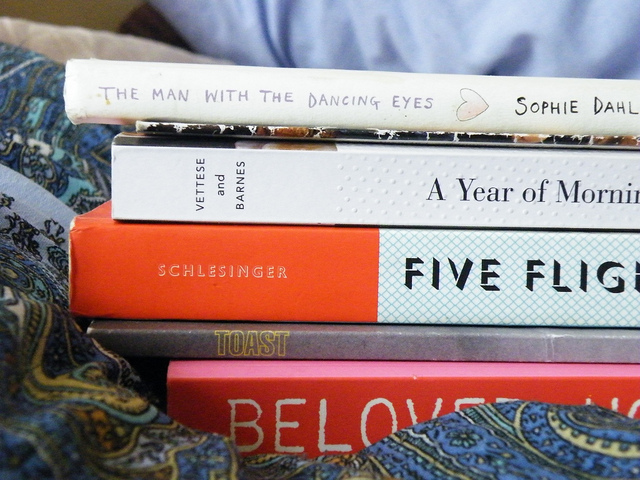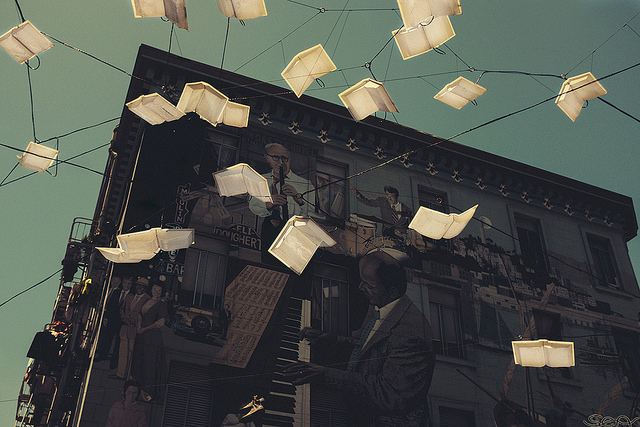Fiction And The Human: 15 Best Short Stories

Flannery O’Connor said “fiction is about everything human,” and in that sense, short stories are worlds and views and pockets of it that you can read within an hour. Here are 15 stories that take you from bananafish to a backpack of stones to the cemetery where Al Jolson is buried.
1. “How to Be An Other Woman” by Lorrie Moore
It’s a story with a lot of Almosts: almost intimacy, almost happiness, almost living. Moore deftly translates the sentiment of being the other woman in an affair saying, “It is like having a book out from the library. It is like constantly having a book out from the library.” We read a step-by-step instruction on how to be on the receiving end of stolen love: the source of something that hurts someone else, how to love someone who is choosing that hurt, and how to feel about it.
2. “Cathedral” by Raymond Carver
We read the story through the eyes of someone who has perfect vision but sees the world in a narrow way. Someone who pities a blind man’s wife, thinking, “Imagine a woman who could never see herself as she was seen in the eyes of her loved one. A woman who could go on day after day and never receive the smallest compliment from her beloved.” And yet, as he interacts with the blind man, he finally sees. Not in a "there is a moral to this story" kind of a way, but by way of finally understanding.
Read it here.
3. “In the Cemetery Where Al Jolson is Buried” by Amy Hempel
Hempel’s class assignment was to write about her worst secret. Laden with a fear of flying and earthquakes—a culmination of a fear of death, her protagonist hides for two months before she faces her dying friend. She visits and immediately itches to leave, already viewing her friend as dead, her remaining time serving as a reinforcement of the narrator’s own life. This both repels her from her duties as “the best friend” and forces her to confront the realities of her fear, which she rejects. Her rejection is through escape: she chooses to rescue herself by not staying to watch her friend expire—reasoning that once one is on the track to dying, there is no point in trying to salvage anything. Her dying friend is forced into becoming part of her fear, leaving the narrator still running, knowing full well that she was given the chance to face the reality of death and could not fill herself with it. She forgives herself for her reprehensible behavior, but because she loved her friend, the reality of sorrow eventually pours into her instead.
Read it here.
4. “Party of One” by Antonya Nelson
A man and a woman have a fight in a bar. But the transaction is more intricate than its standard template of a setting. While Emily and Nicholas are fighting about love, they aren’t lovers; Nicholas is seeing her sister Mona. Through their encounter, the contrast between Emily and Mona’s ways of accepting and receiving love is amplified: Mona loves whole-heartedly, “fell hard, and hurt herself,” while Emily is able to just pull the plug when she needs to. Through Emily’s thoughts, however, it becomes clear that while it hurts to see her sister suffer, the self-destruction that Mona goes through is an indicator of how thick her love capacity is, while Emily’s is thin in comparison. In the end, both Emily and Mona’s forms of love have tragic falls—with both on opposite ends of the spectrum, trying to grasp the middle.
Read it here (New Yorker account required).
5. “The Death of Ivan Ilyich” by Leo Tolstoy
It’s a novella—a short story and a half—and it starts with the main character’s funeral. The novella explores how middle-class morality and values can be the definition of death: that small-minded, self-serving, materialistic day-to-day life is really death. Death is no longer needed as a prompt to analyze modern society because youth does that already. Tolstoy uses death to prompt an investigation of life.
Read it here.
6. “Bohemians” by George Saunders
A 10-year-old boy is sent off for a week to Mrs. Poltoi’s house, one of two “bohemians” in his neighborhood. It’s a working-class neighborhood, and the boy and his friends are a bag of misfit kids who Saunders uses to demonstrate a ripple of friendliness and understanding. There are moments where the old lady and child bond in a sentimental and powerful way, and there are moments when sentimentality is mocked in old-fashioned realism.
Read it here.
7. “In the Gloaming” by Alice Elliott Dark
This is a story of a mother who sees nothing extraordinary in herself except for her kids. Her devotion to her son, Laird, is heartbreaking as she notes that “parents and children were all captive audiences to each other; in view of this, it was amazing how little comprehension there was of one another’s story. Everyone stopped paying attention so early on, thinking they had figured it all out.” Dark portrays the different types of grieving a person goes through—the mother’s sense of hunger, and the father’s sense of distance and avoidance. The fragility of the connections she portrays in the family makes the reader marvel at the fact they are held up at all, and so the heartbreak is harder in the end.
Read it here (New Yorker account required).

Salinger’s style lives up to expectations in this concise and arresting short. He explores the trauma of war, the lack of communication and the destruction it can lead to, and the yearning for innocence. Seymour, back from war and psychologically damaged by its traumas, is unable to properly communicate his feelings (nor does he really want to) with his materialistic wife Muriel. We slip into a childlike fantasy world of bananafish and olives. When it is time to go back to reality, however, Seymour is still searching for the purer world of a child, where redemption is possible. Reality and fantasy are only unblurred at the end, with Seymour’s actions a clear message delivered to the world he was so disconnected from.
Read it here.
9. “Spring in Fialta” by Vladimir Nabokov
In Vladimir Nabokov’s "Spring in Fialta," the description and setting create a mosaic, mirroring the mosaic of memories Victor holds of Nina, with brief vignettes composed to reflect his own portrait of her. Like the “gouache” type of painting he refers to when describing the sky above Fialta, so too is the series of stories reflecting his feelings: heavy, muddy and not so transparent. It never occurs to Victor that there is no more to her than a carefree woman with no desire for attachment and a complete ignorance of the possible pain she may project on someone who loves her. In the end, Victor is longing for something that does not exist.
Read it here.
10. “A Good Man Is Hard to Find” by Flannery O'Connor
This is a classic in creative writing workshops, delicious because the worst character is the tiny grandmother, while the favorite character is her murderer. It’s a story where violence reveals divine grace, and the murderer says “She would of been a good woman, if it had been somebody there to shoot her every minute of her life."
Read it here.
11. “Wants” by Grace Paley
The story is of a woman who runs into her ex-husband while she returns a library book eighteen years overdue. In Grace Paley’s "Wants," precise language is employed to pack emotion into a short space. No quotation marks are used, making the exchange feel more muted, exposing the narrator’s strengths and weaknesses, her past and her present–her needs, desires, and regrets. The dialogue–the interaction–is what brings about a self-reflection of why she is returning the book late, why she never read it, and why she wants to check it out again. The characters of Paley’s story are molded through their dialogue and the natural way they speak: there are no grand declarations, but there are quick vacillations of mood-changes of heart, triggered by seemingly normal, everyday events.
Read it here.
12. “Good Old Neon” by David Foster Wallace
In classic David Foster Wallace fashion, “Good Old Neon” is a narrator’s stream of consciousness, articulating long-winded sentences, the story wraps around itself, adding layer after layer. The narrator recounts his life of tailoring himself to the view of others and living to fit himself neatly into an idealized notion of who he should be—in other people’s opinions, reaching for society’s notion of success and respect. As he speaks to his therapist, he explores the concept of how a person’s feelings, when expressed in spoken language, are often a form of what has already been expressed, and thus unoriginal, and possibly just a reflection of that which he has seen before. The actual experience, however, the totality of the moment, is what struggles to manifest. The distance between the two—what is felt and what is translated—is what makes us realize that some forms of communication cannot satiate, and thus the way we try to make up for it leads to further distance.
Read it here.
13. “The Girl in the Flammable Skirt” by Aimee Bender
A father forces his young daughter to wear a stone backpack that will make her sensitive to suffering. Bender’s diction is specific in its mundaneness, but not overly pedantic, items: pocket lint, rats, cinnamon raisin, backpack of stone. Her vision of each scenario and each emotion is specific, and the narrator’s story is clear and the tone is delivered without stumbling. The daughter’s sensitivity becomes so overwhelming that she envies a girl whose skirt catches on fire. In that moment, Bender says, her passion had arrived. She could feel freely, however fleeting that moment was.
Read it here.
14. “Hills Like White Elephants” by Ernest Hemingway
The entire story is a conversation between an American man and his girlfriend, and demonstrates the power of dialogue versus communication. The American man says almost anything to convince his girlfriend to have an abortion, saying that everything will go back to the way it used to be. Hemingway’s subtleties show us the man’s dominance in their relationship, and both character’s backgrounds and attitudes towards each other and the situation manifest in this conversation.
Read it here.
15. “Powder” by Tobias Wolff
The short story focuses on a son whose father takes him to a bar and then enters a police-blocked path of a snowstorm. The father is rebellious, the kid controlled and contained. In this story, everything seems to point to disaster. The mother and father have split up, and Wolff uses the snow and this moment to change the son: he is so tightly wired that he numbers his clothes hangers. And yet at the moment of looming disaster, he is finally able to relax and recognize the thrill of facing danger with the trust you have for your father in hand.
Read it here.
Contact Contributor Tammy Tarng here.



